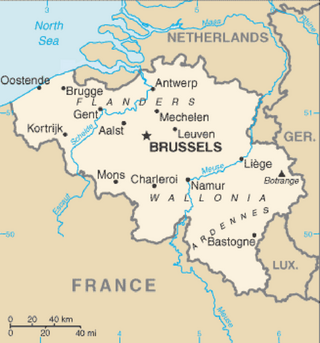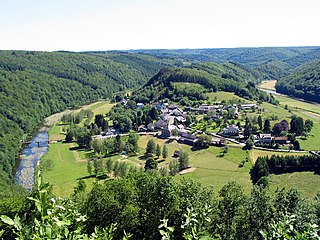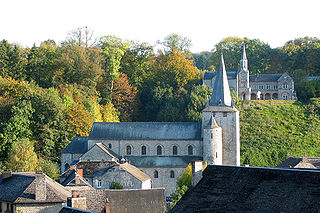
The Meuse or Maas is a major European river, rising in France and flowing through Belgium and the Netherlands before draining into the North Sea from the Rhine–Meuse–Scheldt delta. It has a total length of 925 km.

Belgium is a federal state located in Western Europe, bordering the North Sea. Belgium shares borders with France (620 km), Germany (133 km), Luxembourg (130 km) and the Netherlands (478 km). Belgium is divided into three regions: Flanders, Wallonia and Brussels.

The Ardennes, also known as the Ardennes Forest or Forest of Ardennes, is a region of extensive forests, rough terrain, rolling hills and ridges primarily in Belgium and Luxembourg, extending into Germany and France.

Dinant is a city and municipality of Wallonia located in the province of Namur, Belgium. On the shores of river Meuse, in the Ardennes, it lies 90 kilometres (56 mi) south-east of Brussels, 30 kilometres (19 mi) south-east of Charleroi and 30 kilometres (19 mi) south of the city of Namur. Dinant is situated 20 kilometres (12 mi) north of the border with France.

Houyet is a municipality of Wallonia in the province of Namur, Belgium.

Visé is a city and municipality of Wallonia, located on the river Meuse in the province of Liège, Belgium.

Namur was a county of the Carolingian and later Holy Roman Empire in the Low Countries, a region in northwestern Europe. Its territories largely correspond with the present-day French-speaking Belgian arrondissement Namur together with the northwestern part of the arrondissement Dinant, which are both part of the modern province of Namur. The modern provincial boundaries are based upon the French Republican department of Sambre-et-Meuse.

The Lesse is a river in the Ardennes, in the Walloon region of Belgium. It is a right tributary to the river Meuse.
Naulette, French: Caverne de la Naulette is a large cave located in Wallonia on the left bank of the Lesse, a tributary of the Meuse in the hills above Dinant, Belgium.

Bouvignes-sur-Meuse is a village of Wallonia and a district of the municipality of Dinant, located in the province of Namur, Belgium, on the River Meuse.

The Condroz is a natural region in Wallonia, located to the north-west of the Ardennes. Its unofficial capital is Ciney. The region preserves the name of the Condrusi, a Germanic tribe which inhabited the area in the Roman era.

Jambes is a town of Wallonia and a district of the city of Namur, located in the province of Namur, Belgium.

Celles is a village of Wallonia and a district of the municipality of Houyet, located in the province of Namur, Belgium.

Walzin Castle is a castle in the city of Dinant, Wallonia Belgium in the province Namur over the river Lesse, district of Dréhance. This Gothic Revival castle stands on a steep rock above the right bank of the Lesse, about 5km before it flows into the Meuse. Popular kayak routes allow a view of the castle from the Lesse valley.

Famenne is a natural region in Wallonia. Together with The Fagne or la Fagne, west of the river Meuse, it is part of the Fagne-Famenne natural region. The two regions are often grouped together because they are quite similar both geographically and naturally.

The Lomme, Lhomme or L'Homme is a river in the Ardennes, in the Walloon region of Belgium. It is a right tributary to the river Lesse, itself a right tributary of the river Meuse.

The Battle of Dinant was an engagement fought by French and German forces in and around the Belgian town of Dinant in the First World War, during the German invasion of Belgium. The French Fifth Army and the British Expeditionary Force (BEF) advanced into Belgium and fought the Battle of Charleroi (21–23 August) and Battle of Mons (23 August), from the Meuse crossings in the east, to Mons in the west. On 15 August 1914, German troops captured the Citadel of Dinant which overlooked the town; the citadel was recaptured by a French counter-attack during the afternoon.
This page is based on this
Wikipedia article Text is available under the
CC BY-SA 4.0 license; additional terms may apply.
Images, videos and audio are available under their respective licenses.

















